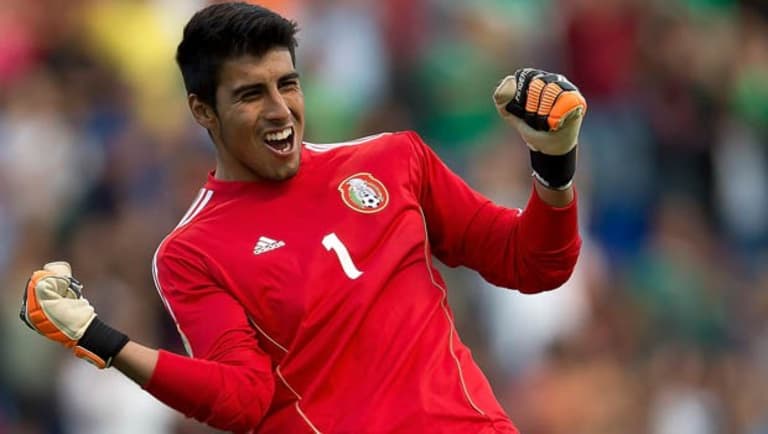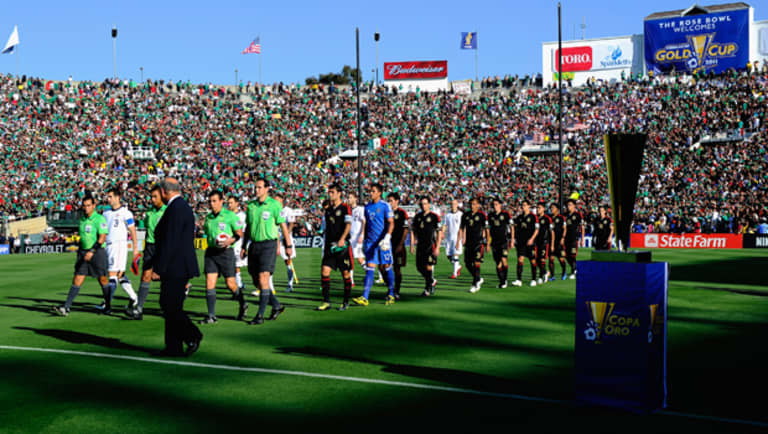Here we go again. Mexico-USA at the Azteca.
Around these parts, it doesn’t get any bigger than this. At least, from a soccer perspective.
Actually, maybe from a non-soccer perspective, too. After all, the Mexico-USA relationship is as complicated and charged as a Diego Rivera mural, and the struggle on the field often bears the weight of that dynamic.
Which is why Mexico-USA is not only as big as it gets in these parts, but also as big as it gets anywhere. I’ve argued this before, in bits and pieces, but it seems the time has come, given all the twittering going on, to put it out there, as plainly and succinctly as possible so no one can misunderstand or misconstrue what I’m trying to say here:
Mexico-USA is the best rivalry in international soccer. Period.
Ha! I can already hear the European traditionalists’ gasps. What about England-Germany? they’re wheezing. Netherlands-Germany? France-Spain? France-Italy?
Sure, I respond, those European matchups are great. They have history on the field and some bad blood off it, often shrouded in the mists of war.
Down in South America, people are probably choking on their maté. "What about Brazil-Argentina?" they sputter.
I’ll admit a Brazil-Argentina clash is a showcase of breathtaking talent, but there is no serious fractiousness between the nations.
The truth is, though, none of those matchups contains the same explosive mixture of on- and off-the-field factors that the Mexico-USA rivalry does.
After talking to a handful of people about this, I’ve broken the argument down into three parts.

- The Battle for Supremacy
There can be no argument that Mexico and the USA are the two best teams in CONCACAF.
Between the two of them, they have won the Gold Cup 10 of the 11 times its been contested since 1991; they’ve met in the final five times, including the last three. In the World Cup, they have the most appearances (Mexico 14, USA 9) among CONCACAF nations, and remain the only CONCACAF nations to reach the knockout stage of any tournament since World War II.
This duopoly raises the stakes: Nearly every time the Yanks and El Tri meet, something very real is on the line — a trophy, a World Cup berth, a spot in the World Cup quarterfinals, etc. They are each other’s barometer of success.
No other region has a rivalry as consequentially binary as this. Europe has five or six nations who consistently contend for top honors. South America might seem like a two-horse-race between Brazil and Argentina, but reigning Copa América champions Uruguay might brandish their two World Cup trophies as counter-argument. Asia and Africa both have five or six top nations, if not more.
READ: USMNT try to downplay friendly victory at Azteca last August
The only confederation that ever came close was Oceania, which used to enjoy a decent back-and-forth between Australia and New Zealand. But once the Aussies bolted for Asia in 2006, the OFC become a foregone conclusion for the Kiwis.
An added part of this debate comes down to style. The Mexicans and US play very different styles, the former opting for a more possession-oriented tactical style, the latter going most often for power and physicality. Despite 15 years of relative evenness in terms of results, both sides are convinced that their style is superior.
Funnily enough, the truly successful style might lie somewhere in between. Or not, as another friend pointed out: “A buddy of mine once said if you combined the two, you'd either have a great team or one that wouldn't be able to figure out how to play together.”

- The Battle for Players
Jose Francisco Torres, Joe Corona, Edgar Castillo, Michael Orozco Fiscal, Richard Sanchez, Omar Salgado...
The list goes on. Players of Mexican heritage who were born in the United States and then find themselves facing a decision: Should I represent my birth nation or their ancestral homeland?
It’s a vexing question for any child of an immigrant to answer, whether or not soccer is involved. But the soccer or fútbol issue amplifies the pressures, and heightens the stakes even more.
Last August, when Orozco Fiscal scored in the United States’ 1-0 friendly win over El Tri, the Yanks’ first-ever victory in Mexico, the paradox of it all was laid as bare as can be: Here was the son of Mexican immigrants, who was born and raised in Southern California, who joined Mexican club San Luis at age 19, scoring for los Americanos to beat El Tri on the hallowed ground that is the field at Estadio Azteca.
Cultural and familial connections to the “old country” are not unique to the USA and Mexico. The many Turkish internationals born and raised in Germany are one example. So are the handful of Argentines (and one conspicuous American) who chose to play for Italy. And there are numerous French-born players who wind up representing countries in North and West Africa.
But those nations are not rivals of any serious kind. Sure, they might play each other now and then, and the players’ cultural connections will be discussed, but there is no venom to it all. And the decision of a German-born player representing Turkey, for example, is chalked up to globalization or opportunism.
For the most part, the Mexican-Americans have chosen to play for the United States. Even Edgar Castillo, who donned the Mexican jersey in three friendlies, ultimately opted for the American side.

Richard Sanchez
, a Homegrown player with FC Dallas, is another story. He is the No. 1 goalkeeper for the Mexican U-20 squad, having backstopped their U-17 team to the World Cup title in 2009.
READ: Gomez says USA-Mexico rivalry has changed
And there is also another unique story to consider. Current US national team assistant coach Martin Vasquez was born in Mexico, moved to Los Angeles when he was 12, then returned to Mexico and eventually played three times for El Tri in the early ’90s. But like Castillo after him, he then switched allegiances and earned seven caps for the United States under Steve Sampson.
The future certainly has more of these situations, particularly now that the fight for players between the clubs has intensified. Mexican clubs, such as Pachuca, San Luis, and Tijuana are actively recruiting young Mexican-American players in the United States. The emergence of MLS as true competition the Mexican league means that more and more players, particularly Mexican-Americans, will face a difficult choice in the future. From such emotional and wrought decisions comes the passion that drives a true rivalry.
3. The Battle for Hearts and Minds
The true complexity of the Mexico-USA rivalry, of course, has nothing to do with soccer. It’s about the heart. And memory. And politics, patriotism, power.
Here’s how one friend put it:
“There is something compelling for many Mexican-Americans to root for Mexico because it is one of the only arenas in which Mexico has been traditionally superior to the United States,” she wrote. “I know for some of these folks, it is frontrunning, but for some of them it is a way to take pride in their heritage when they are often marginalized and sometimes demonized economically/culturally/socially because of said heritage.”

This might be one of the most fascinating aspects of the Mexico-US rivalry: From a pure data perspective (TV ratings, sponsorship revenues, match attendance, etc.), El Tri challenges the US national team for popularity in the United States. After all, there are roughly 35 million Mexicans and Mexican-Americans in the United States.
It explains why, when the United States plays Mexico in Los Angeles or Houston or Chicago or New York, they find most of the crowd rooting against them. Where else in the world does that happen? An Argentina-Brazil match in Buenos Aires would never see 80 percent of the fans wearing yellow. Going back to that Germany-Turkey comparison: A few years ago, the two sides played a friendly in Munich, but only roughly 10 percent of the fans supported Turkey, which, as my colleague Matt Doyle pointed out, "is a loss of homefield advantage in Europe."
This is changing. As the US national team, MLS, and soccer grow in popularity, more fans — of diverse heritages, including Mexican, it should be pointed out — come to the stadium to shout “U-S-A! U-S-A!” Still, there is a reason the U.S. Soccer Federation recently chose Columbus as the venue for the World Cup qualifier against Mexico in September rather than the Rose Bowl or Soldier Field: They know they will have a partisan crowd in their favor.
READ: Complete preview of Tuesday night's massive Mexico-USA clash
What I haven’t really taken into account in my three “battles” is the nations’ social history. There is plenty of that, obviously, including wars, land-grabs, and massacres.
But I do not lend as much weight to that. Because the reason Mexico-USA is the best rivalry is not based on a contentious geopolitical history, as it often is in Europe. It is based on a current geopolitical contentiousness. And it is based on soccer. On the rise of the US national team in the 2000s, and the resurgent Mexican national team of the 2010s.
I’ll leave you with the words of one more friend, a Mexican-American who was born an hour outside of Mexico City, was raised in Los Angeles and Kansas City, and now lives in New York. He will root for Mexico on Tuesday night against the United States:
"Jugamos como nunca I perdimos como siempre." This translates to "We played like never before but lost like always." The quote that has haunted every Mexican soccer fan since as long as I have the sense of reason.
To me what changed everything was 2002. Mexico was focused on the quarterfinals in the World Cup. They had nothing to worry about with the US. Then they lost. And since then, it's been even more personal, in my eyes at least. Dropping the ball in the biggest stage still haunts Mexico to this day. So close, yet so far. When was the last or next time Mexico will face the US in a game with more on the line that that match?
Since then, I think it changed our perspective as the so-called giants of CONCACAF. We have had that chip on our shoulders/fear that it will change. Which slowly it has, and possibly one day will.












